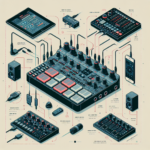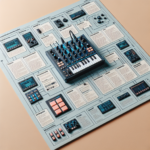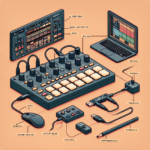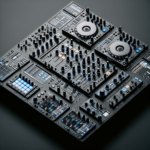Akai MPD232: Comprehensive Guide to Features, Setup, and Performance
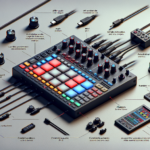
Introduction
The Akai MPD232 is a versatile MIDI controller designed to meet the needs of both novice and professional musicians. This device is part of Akai’s renowned MPD series, which has been a staple in the music production industry for years. The MPD232 is particularly aimed at beatmakers, producers, and live performers who require a reliable and feature-rich controller to enhance their creative workflow.
Akai Professional is a well-established brand in the music industry, known for its innovative and high-quality products. With a legacy that spans over three decades, Akai has consistently delivered tools that empower musicians to push the boundaries of their creativity.
Key Features Overview:
- 16 Thick Fat backlit MPC pads with velocity and aftertouch
- 64 assignable pads accessible via 4 banks
- 8 assignable faders, 8 assignable Q-Link knobs, and 8 assignable Q-Link buttons
- Built-in step sequencer
- Comprehensive MIDI control
- Full-color LCD screen for easy navigation
Design and Build Quality
Physical Design
The Akai MPD232 boasts a sleek and modern design, featuring a compact form factor that measures approximately 16.1 x 9.6 x 1.9 inches and weighs around 3.7 pounds. The controller is constructed from high-quality plastic, which ensures durability while keeping the weight manageable. The 16 backlit MPC pads are thick and responsive, providing a tactile feel that is reminiscent of Akai’s legendary MPC series.
Portability
Given its compact size and lightweight design, the MPD232 is highly portable. It can easily fit into a backpack or a small carrying case, making it an excellent choice for musicians who need a reliable controller on the go. Whether you’re heading to a studio session or a live performance, the MPD232’s portability ensures that you can take your music production setup with you wherever you go.
Durability
The build quality of the MPD232 is impressive, with a robust construction that can withstand the rigors of regular use. The pads, knobs, and faders are all designed to endure heavy usage, ensuring that the controller remains functional and reliable over time. Akai’s reputation for producing durable and long-lasting equipment is evident in the MPD232’s design.
Setup and Configuration
Initial Setup
Setting up the Akai MPD232 is a straightforward process. Follow these steps to get started:
- Unbox the MPD232 and connect it to your computer using the provided USB cable.
- Power on the controller by pressing the power button.
- Ensure that your computer recognizes the device. You may need to install drivers if prompted.
Software Installation
To fully utilize the MPD232, you will need to install the necessary software and drivers. Follow these steps:
- Visit the Akai Professional website and navigate to the MPD232 product page.
- Download the latest drivers and software, including the Akai Pro MPC Essentials software.
- Install the downloaded software and follow the on-screen instructions to complete the installation process.
Compatibility
The Akai MPD232 is compatible with a wide range of operating systems and DAWs. Here is a list of compatible systems:
- Operating Systems: Windows 7, 8, 10, macOS 10.10 and later
- DAWs: Ableton Live, FL Studio, Logic Pro, Cubase, Pro Tools, and more
- Other Software: Akai Pro MPC Essentials, Reason, Studio One
Features and Functionality
Key Features
The Akai MPD232 is packed with features that make it a powerful tool for music production and performance:
- MPC Pads: The 16 backlit MPC pads are highly responsive and feature velocity sensitivity and aftertouch, allowing for expressive and dynamic performances.
- Assignable Controls: The controller includes 8 faders, 8 Q-Link knobs, and 8 Q-Link buttons, all of which are fully assignable to various parameters within your DAW or software.
- Step Sequencer: The built-in step sequencer allows you to create and edit patterns on the fly, making it easy to build complex rhythms and sequences.
- LCD Screen: The full-color LCD screen provides clear and intuitive navigation, allowing you to access and adjust settings with ease.
Customizability
The MPD232 offers extensive customization options, allowing users to tailor the controller to their specific needs. You can easily assign MIDI functions to the pads, knobs, and faders using the included software. Additionally, the controller supports MIDI mapping, enabling you to create custom layouts and configurations for different projects and workflows.
Unique Functions
One of the standout features of the MPD232 is its built-in step sequencer. This feature allows you to create intricate patterns and sequences directly on the controller, without the need for additional software. The step sequencer is highly intuitive and offers a range of options for editing and manipulating your sequences.
Integration with DAWs
The MPD232 seamlessly integrates with popular DAWs, providing a smooth and efficient workflow. For example:
- Ableton Live: The controller is pre-mapped to work with Ableton Live, allowing you to control various parameters and functions directly from the MPD232.
- FL Studio: The MPD232 is fully compatible with FL Studio, enabling you to trigger samples, control effects, and manipulate patterns with ease.
- Logic Pro: The controller integrates seamlessly with Logic Pro, providing hands-on control over your projects and enhancing your creative process.
Advanced Features
The MPD232 includes several advanced features that set it apart from other MIDI controllers:
- Aftertouch: The pads feature aftertouch, allowing for expressive and dynamic performances.
- Arpeggiator: The built-in arpeggiator provides a range of options for creating complex and evolving patterns.
- Chord Modes: The controller includes various chord modes, enabling you to play chords with a single pad press.
Performance
Latency and Responsiveness
The Akai MPD232 excels in terms of latency and responsiveness. The pads are highly sensitive and provide immediate feedback, ensuring that your performances are tight and accurate. The controller’s low latency makes it suitable for both studio production and live performances, where timing is crucial.
Real-World Usage
In practical scenarios, the MPD232 performs exceptionally well. Whether you’re using it in a studio environment or during a live performance, the controller’s features and functionality enhance your workflow and creative process. The step sequencer is particularly useful for building complex rhythms on the fly, while the assignable controls provide hands-on control over your DAW and software.
User Experience
User feedback for the MPD232 is overwhelmingly positive. Musicians and producers appreciate the controller’s build quality, responsiveness, and extensive feature set. The intuitive layout and customizable options make it a favorite among both beginners and professionals.
Applications and Use Cases
Beginner vs. Professional Use
The Akai MPD232 is suitable for both beginners and professionals. Its intuitive design and user-friendly features make it accessible to newcomers, while its advanced functionality and customization options cater to the needs of experienced musicians and producers.
Studio Use
In a studio environment, the MPD232 excels as a versatile and powerful MIDI controller. It is ideal for music production, recording, and sound design, providing hands-on control over your DAW and software. The step sequencer and assignable controls enhance your workflow, allowing you to create and manipulate sounds with ease.
Live Performance
The MPD232 is also well-suited for live performances. Its portability, durability, and low latency make it a reliable choice for musicians who need a dependable controller on stage. The built-in step sequencer and arpeggiator provide additional creative options for live sets, while the responsive pads ensure that your performances are dynamic and expressive.
Specific Genres
The MPD232 excels in various genres of music, including:
- EDM: The controller’s step sequencer and arpeggiator are perfect for creating intricate electronic patterns and sequences.
- Hip-Hop: The responsive pads and assignable controls make it an excellent choice for beatmaking and sample triggering.
- Classical: The chord modes and aftertouch provide expressive options for classical compositions and performances.
Pros and Cons
Pros:
- Highly responsive and durable MPC pads
- Extensive customization options
- Built-in step sequencer and arpeggiator
- Seamless integration with popular DAWs
- Portable and lightweight design
Cons:
- Limited standalone functionality (requires a computer or other hardware)
- Initial setup and software installation can be time-consuming
- Some users may find the learning curve steep for advanced features
Common Issues and Troubleshooting
Known Issues
While the MPD232 is generally well-received, some users have reported common issues such as:
- Occasional connectivity problems with certain DAWs
- Software compatibility issues with older operating systems
- Pad sensitivity inconsistencies
Troubleshooting Tips
If you encounter any issues with the MPD232, try the following troubleshooting tips:
- Ensure that you have installed the latest drivers and software updates from the Akai Professional website.
- Check your USB connections and try using a different USB port or cable.
- Consult the user manual and online forums for additional troubleshooting advice.
Customer Support
Akai Professional offers reliable customer support for the MPD232. Users can access support through the Akai website, where they can find FAQs, user manuals, and contact information for technical assistance. The brand’s customer support team is known for being responsive and helpful, ensuring that any issues are resolved promptly.
Comparisons with Similar Controllers
Competitor Comparison
When compared to similar MIDI controllers from other brands, the Akai MPD232 stands out for its combination of features, build quality, and price point. Competitors such as the Novation Launchpad Pro and Native Instruments Maschine Mikro offer similar functionality but may differ in terms of pad sensitivity, customization options, and software integration.
Feature Comparison
Here is a comparison of the MPD232 with its competitors:
- Novation Launchpad Pro: While the Launchpad Pro offers a grid-based layout and excellent integration with Ableton Live, it lacks the built-in step sequencer and arpeggiator found in the MPD232.
- Native Instruments Maschine Mikro: The Maschine Mikro provides a comprehensive software suite and deep integration with Native Instruments’ ecosystem, but it may be more expensive and less portable than the MPD232.
Conclusion
Summary
The Akai MPD232 is a versatile and feature-rich MIDI controller that caters to the needs of both beginners and professionals. Its responsive pads, extensive customization options, and built-in step sequencer make it a powerful tool for music production and live performance.
Who Should Buy This?
The MPD232 is ideal for beatmakers, producers, and live performers who require a reliable and portable MIDI controller. Its intuitive design and advanced features make it suitable for a wide range of musical genres and applications.
Final Thoughts
Overall, the Akai MPD232 is a well-rounded and highly capable MIDI controller that offers excellent value for money. Its combination of features, build quality, and performance make it a standout choice in its category.
FAQ
Is the Akai MPD232 compatible with my DAW?
The MPD232 is compatible with a wide range of DAWs, including Ableton Live, FL Studio, Logic Pro, Cubase, Pro Tools, and more.
Do I need to install any software to use the MPD232?
Yes, you will need to install the necessary drivers and software, including the Akai Pro MPC Essentials software, to fully utilize the MPD232’s features.
Can I use the MPD232 without a computer?
The MPD232 is primarily designed to be used with a computer or other hardware. While it offers some standalone functionality, it is best used in conjunction with a DAW or software.
How do I customize the controls on the MPD232?
You can customize the controls using the included software, which allows you to assign MIDI functions to the pads, knobs, and faders. The controller also supports MIDI mapping for creating custom layouts.
Is the MPD232 suitable for live performances?
Yes, the MPD232 is highly portable and durable, making it an excellent choice for live performances. Its low latency and responsive pads ensure that your performances are dynamic and accurate.
Where to Buy
The Akai MPD232 can be purchased from various retailers, including major music equipment stores and online marketplaces. Some of the well-known retailers that carry the MPD232 include Guitar Center, Sweetwater, and Amazon. Be sure to check for availability and pricing at your preferred retailer.

